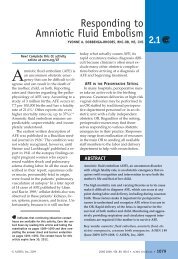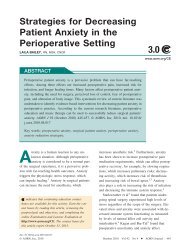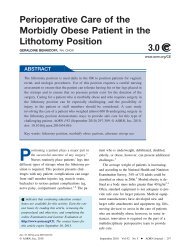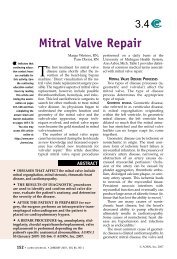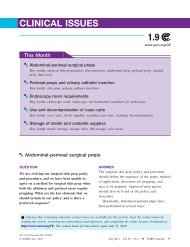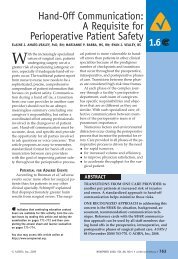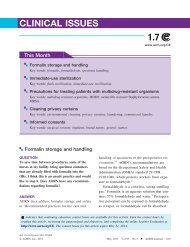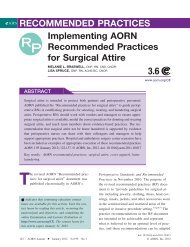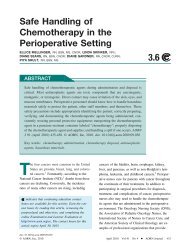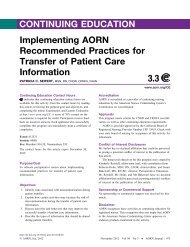Cerebral Aneurysm—Treatment and Perioperative Nursing ... - AORN
Cerebral Aneurysm—Treatment and Perioperative Nursing ... - AORN
Cerebral Aneurysm—Treatment and Perioperative Nursing ... - AORN
Create successful ePaper yourself
Turn your PDF publications into a flip-book with our unique Google optimized e-Paper software.
Wright JUNE 2007, VOL 85, NO 6Figure 6 • Two titanium clipsare applied to the neck ofthe aneurysm.deployed. He or she placesan arterial sealing devicein the femoral arterypuncture site after theprocedure is complete <strong>and</strong>applies pressure to thearea for several minutesbefore applying a femoralwound dressing.POSTOPERATIVE NURSING CAREAs the patient is waking from anesthesiain the OR, the anesthesia careprovider reminds the patient not to movethe leg in which the angiogram was performed.The surgical team then carefullytransfers the patient to a hospital bed.The circulating nurse secures a sheetover the patient’s surgical leg <strong>and</strong> tucks itunder the mattress on both sides of thebed to help prevent unnecessary legmovement. The anesthesia care provider<strong>and</strong> circulating nurse transport the patientto the postanesthesia care unit(PACU), where both provide a detailedh<strong>and</strong>-off report to the receiving PACUnurse. The circulating nurse ensures thatthe PACU nurse is aware of any neurologicaldeficits that the patient may havepresented with preoperatively.The PACU nurse documents the patient’sarrival vital signs <strong>and</strong> performs aneurological assessment. The nursechecks the cranial <strong>and</strong> femoral dressingsfor bleeding <strong>and</strong> checks the patient’spedal pulses for evidence of occlusion.The patient remains on bed restwith the affected leg extended for a periodof time determined by the surgeon.The PACU nurse remains vigilant <strong>and</strong>immediately reports any signs <strong>and</strong>symptoms of a retroperitoneal bleeding(eg, low systolic blood pressure, abdominalpain or discomfort) or evidenceof hemorrhage or vasospasm (eg,neurological deterioration).Typically, a patient who has undergonecraniotomy for aneurysm clippingspends two nights in an intensivecare unit (ICU) <strong>and</strong> an additional threenights in a medical-surgical unit beforebeing discharged home. In contrast,a patient who has undergone anendovascular coiling procedure typicallyspends one night in ICU <strong>and</strong> oneadditional night in a medical-surgicalunit. Either treatment course may requirerehabilitation before the patientis discharged home, depending onhow the patient recovers or if he or sheexperiences complications.abcFigure 7 • Tinyplatinum coilsare fed througha catheter (a)<strong>and</strong> deployedinto theaneurysm (b).The coils <strong>and</strong>subsequentblood clotfill theaneurysm (c).<strong>AORN</strong> JOURNAL • 1181



